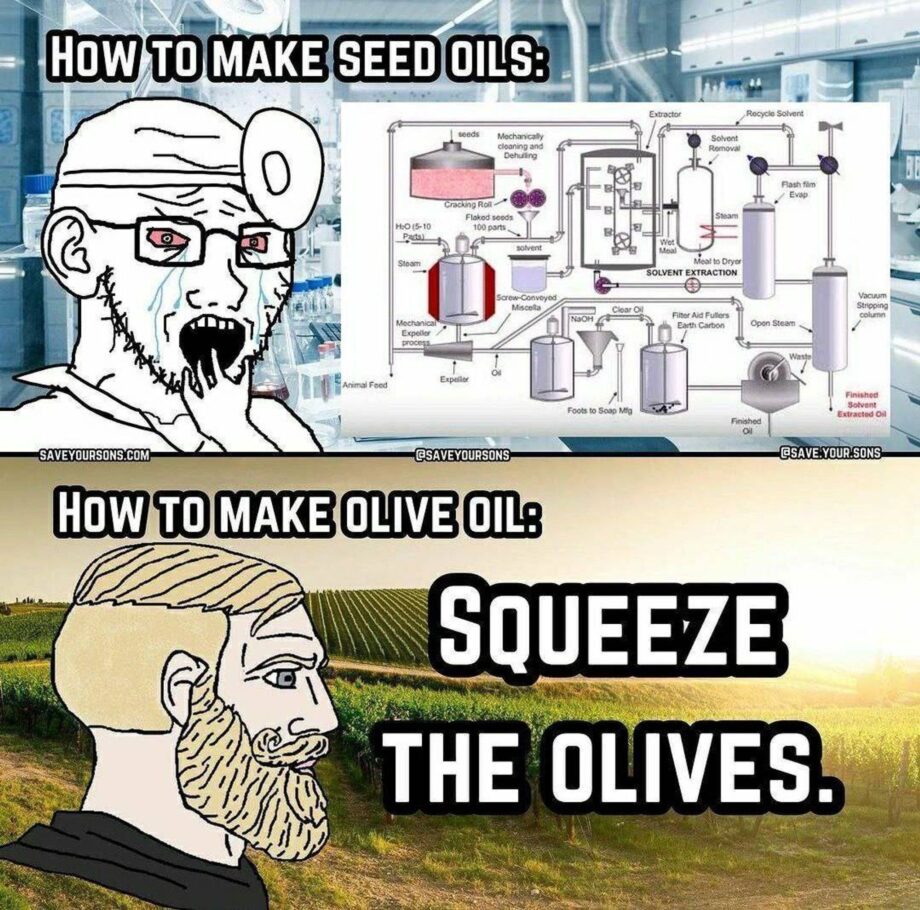With a rising concern for our health, the nationwide increase in health insurance, and alarming disease rates, every element of human nutrition is being examined to find out what is going wrong. The proliferation of podcasts and social media has made the conversation around seed oils a hot topic.
As a society, our consumption of seed oils has risen 1000-fold since 1960, paralleling a rise in obesity, type 2 diabetes, cancer, neurodegenerative diseases, and numerous other inflammatory diseases (1). Yet, up until recently, individuals concerned about the effects of these chemically created substances on their health needed to consult seemingly obscured resources for information outside of the accepted news channels. It baffles me why individuals are not allowed to question what is best for their health.

What Are The Benefits Of Consuming Seed Oils?
Let’s start with the end in mind: What are the benefits of consuming seed oils? What is the established and accepted reason, outside of cheaper cost, for someone to purchase a bottle of seed oils? Maybe the bigger issue is that we don’t grocery shop for the beneficial effects of food in general.
The generally accepted “benefit” of consuming seed oils is in the small perspective that lower LDL cholesterol is better for your health. Do we know how seed oils affect our hearts? Our brains? Our metabolisms?
There are a lot of questions to answer.
What Is A Seed Oil?
“Seed oil” and “vegetable oil” are interchangeably used. The purpose of calling a chemically engineered product a “vegetable oil” is mental gymnastics and play on words to associate the health benefits of vegetables with the toxic byproducts extracted from seeds, plants, and nuts.
Marketing at its finest.
Seed oils are a general term that includes canola (rapeseed), soybean, sunflower, corn, safflower, peanut, cottonseed, sesame, and rice bran. I’m sure there are new types being cooked up in a lab somewhere right now.
Seed oils are high in an omega-6 polyunsaturated fat known as Linoleic Acid. From the beginning, seed oils were manufactured to make food taste better by bulldozing our senses and taste buds. With the popularity of mass food production and shelf-stable items, chemists needed something to keep our food fresh and tasty for longer. It’s just business.
After all, food found in nature has antioxidants to “preserve” it before it is picked and becomes unedible, but seed oils are shelf-stable for years due to chemical preservatives. Seed oils are mechanically created, industrially produced oxidized fats. That is why they are not healthy. Part of the reason that high linoleic acid seeds and nuts have health benefits is because they are multi-nutrient. They aren’t just linoleic acid removed, and consumed alone, like seed oils are.
Omega 6 Fats Vs Seed Oils
I’m not sure why trainers, nutritionists, and online influencers tell their followers that seed oils are healthy. Throw out all the “science” talk, ignore all the data for a second, and look at the fact that seed oils are manufactured products with added chemicals, bleaches, and deodorizers. No “pro” seed oil advocate can deny that. At face value, someone is telling you to consume a product that is bleached, deodorized, and oxidized and not to worry about that at all.
I believe that the confusion stems from the omega-6 linoleic acid content versus the actual seed oil production.
Our problem began when society consumed more omega-6 fats than omega-3 fats in general. This largely is a result of seed oil consumption with our blood ratio of omega 6 to omega 3 being estimated as high as 20:1. It is an established medical fact, even outside of the seed oil debate, that overconsumption of omega-6 fat increases inflammation and is a driver of obesity (2,3,4).
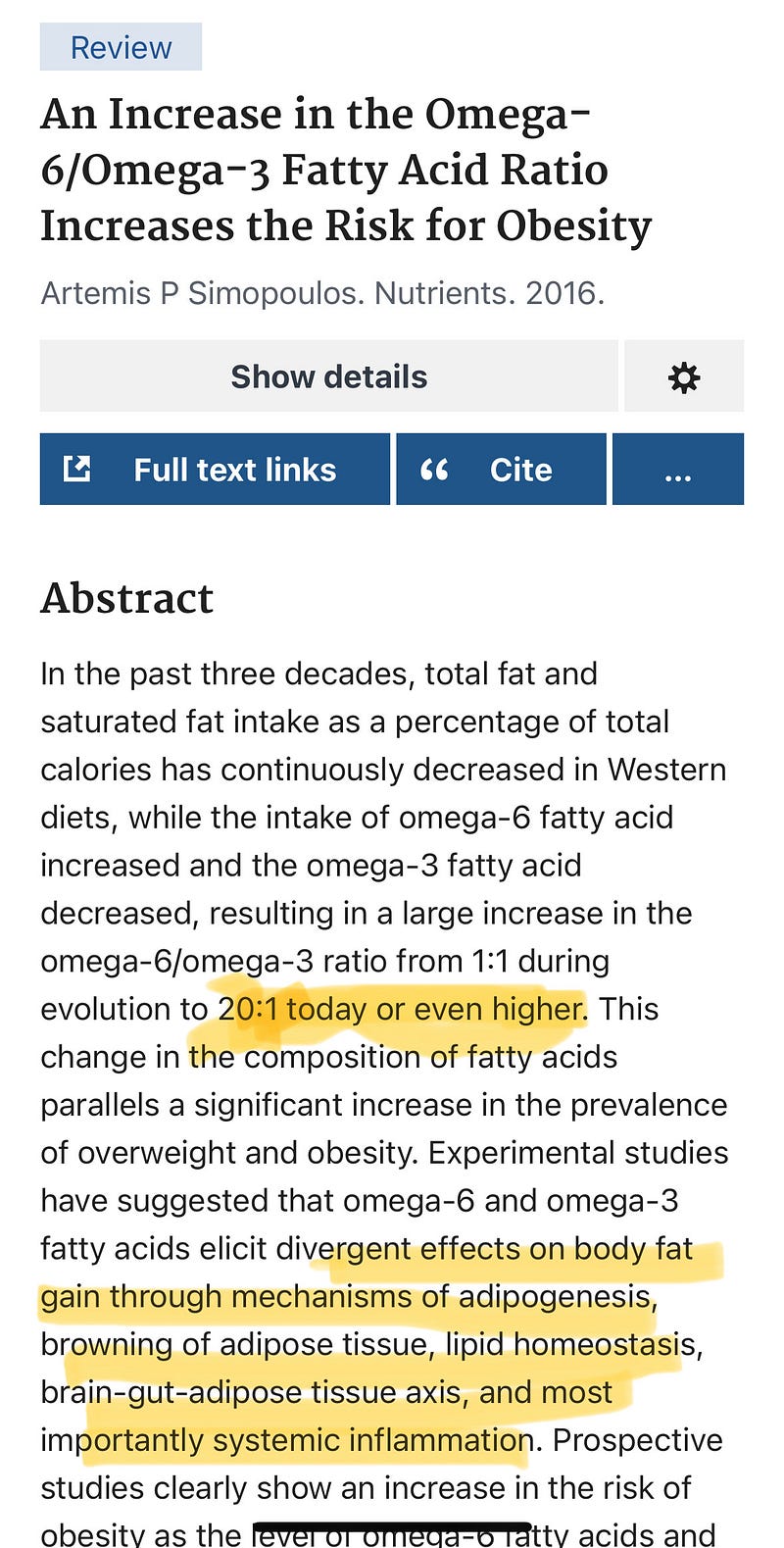
It is difficult, if not impossible, to skew the omega 6 to omega 3 ratio upward of 20:1 without consuming seed oils. There’s just not enough omega-6 isolated food available to accomplish that.
Omega 6, just like omega 3, is an essential fatty acid. You need omega-6 fats in your diet because your body can not produce them on its own. Our hunter-gatherer ancestors routinely consumed both omega-6 fats and omega-3 fats. Yes, omega 6, in the form of linoleic acid is found in nature in foods such as walnuts, almonds, sunflower seeds, and even in eggs, olive oil, fish, and meats. Evolutionarily it makes sense. Different foods are “in season” at other times of the year.
Linoleic Acid causes insulin resistance which was likely required for our ancestors to survive long, cold winters. They needed more body fat. The calorically dense linoleic acid high seeds and nuts that were eaten during times of famine and winter allowed our ancestors to survive until fresh fruits, vegetables and roaming animals increased in the warmer months or climates.
Omega 6’s are not exclusively found in isolation without omega 3’s however. You can walk the globe without finding any abundant seed oils in nature. When you go cold water fishing in Alaska, the salmon you catch isn’t filled with seed oil. The elk that you humanly kill isn’t filled with seed oil. The berries that you pick off a tree aren’t filled with seed oils.
While linoleic acid exists in nature for good reasons, you can’t pluck a seed oil from a tree as you can an olive oil. You can’t produce seed oil from an animal like you can butter from a cow or goat.
Linoleic Acid is the fat source in seed oils but there is a HUGE difference between linoleic acid from sunflower seeds and the seed oil version of sunflower oil. This is where I feel many of the “seed oils are healthy” proponents strike out. It’s okay to have seeds and nuts if you like them and if they fit in with your diet. The linoleic acid in seeds and nuts is not the same as linoleic acid in processed seed oils. Egg yolks are high in linoleic acid and you should eat eggs, not for the linoleic acid but the protein, lutein, and choline among other nutrients. Many types of nuts high in linoleic acid are also high in vitamin E which is cardio-protective.
My point is that the only linoleic acid that you consume should be in the form of natural foods. Don’t seek out linoleic acid just eat whole unprocessed foods.
At this point, you have likely thought about the last time that you purchased a bottle of seed oil at a grocery store. If you’re anything like me, the answer is not recently. I only ever sought out a bottle of seed oils when I was making brownies. I’m assuming you have a similar answer.
No matter what the packaged processed food is, it contains seed oils unless it explicitly states that they only use tallow, olive oil, coconut oil, or avocado oil. Seed oils are everywhere. They are in “healthy” salad dressings, organic chips, and “low calorie” prepared meals.
The Production Of Seed Oils Makes Them Toxic Chemicals
Seed oils become problematic at the very beginning of production when hexane is introduced.
“Hexane is a solvent used extensively in the food industry for the extraction of various products such as vegetable oils, fats, flavors, fragrances, color additives, or other bioactive ingredients. As it is classified as a “processing aid”, it does not have to be declared on the label under current legislation. Therefore, although traces of hexane may be found in final products, especially in processed products, its presence is not known to consumers. However, hexane, and in particular the n-hexane isomer, has been shown to be neurotoxic to humans and has even been listed as a cause of occupational diseases in several European countries since the 1970s” (5)
“it does not have to be declared on the label”
That’s comforting.
In America, a chemical like hexane has to be proven harmful before the Food and Drug Administration prevents its use. In Europe, a chemical used in foods has to be proven safe before it can be used. That’s a big difference. That’s why Europe can’t use some chemicals and we readily do.
There are toxic metabolites of seed oils including aldehyde and toximitablate which are linked to further cognitive and metabolic issues. (6,23). The process of creating a seed oil strips it of whatever antioxidants it may have had prior to production. These antioxidants like Vitamin E are actually protective and may counteract the pro-inflammatory properties of seed oils.
Another toxin resulting from the creation of seed oils is a chemical known as 4-hydroxynonenal (4HNE), a by-product of oxidative stress and linked in studies to cancer, diabetes, and Alzheimer’s disease. Have you heard that eating french fries is as bad as smoking cigarettes? That’s because both a french fry and a cigarette contain 4HNE. (7,28)
Literally, by the time we take our bottle of seed oils or a seed oil-based packaged food home from the grocery store, it is already oxidized.
What Seed Oils Really Do In The Body
Your body is mostly comprised of fat. When you consume seed oils, the linoleic acid is taken up in the phospholipids, cardiolipin (molecules bound up within our mitochondria), mitochondrial membranes, and different lipoproteins. Once taken up, the half life of seed oils in adipose tissue is a minimum of 2 years. It takes a minimum of 2 years for seed oils to leave our body! They are exerting their negative impacts for that long and it might be even longer(8).
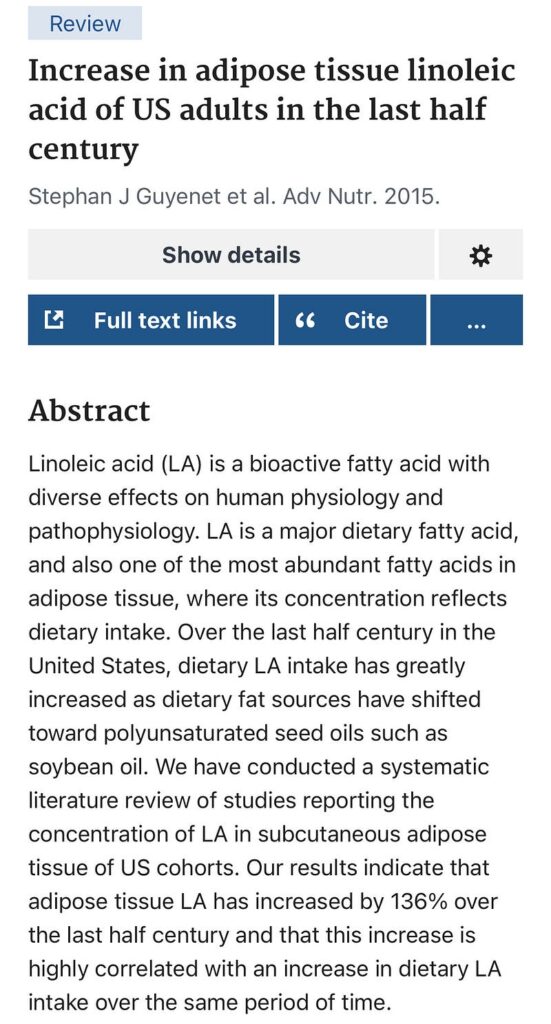
The amount of linoleic acid not only accumulates in adipose tissue but also platelets and is directly attributed to increased coronary artery disease. Linoleic acid has been shown in both cholesterol fatty acids and phospholipid fatty acids to be strongly associated with cardiovascular disease and NOT with individuals without cardiovascular disease. (9,10)
In the early 1950’s the linoleic acid amount of our adipose tissue was in the low single digits. By 2015, when the review was published, linoleic acid concentrations in adipose tissue increased by over 136% percent driven by an increase in dietary linoleic acid. (11)
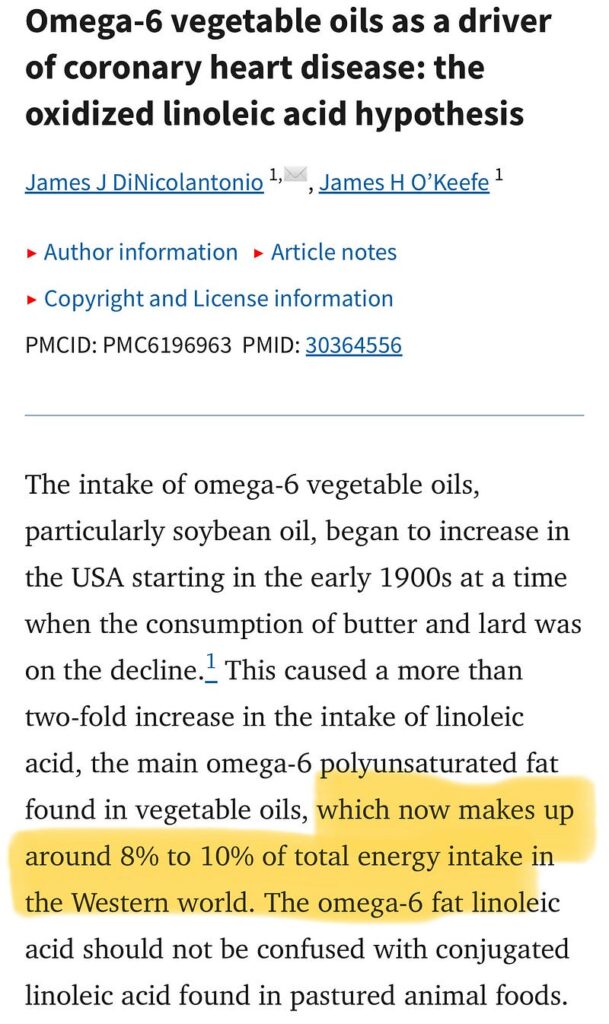
In 2023, the average American consumed three cups of soybean oil weekly and 12 million tons of soybean oil for the year. If you divide that per person, that’s 81 and a half pounds of soybean oil and 7 tablespoons per day.
Seed oil consumption is estimated to account for roughly 8–10% of total calories. Think of how different your body would look if you consumed 8–10% of your total calories from just a seed oil. (9,27).
The more that we eat the more that it accumulates in our cells. Combine that with the fact that linoleic acid takes at minimum two years to clear from our cells and we begin to see that the literal composition of our cells shifts from an omega 3 enriched cell to a degenerative omega 6 cell.
Not only is the seed oil oxidized itself but it makes our cells more likely to get oxidized and continue with time. Our cells change their properties and begin to produce toxic metabolites. Now other cells are impacted by a negative cycle of oxidation that eats mitochondrial cells from the inside including potentially impairing gene expression and cell signaling itself. (12,13)
Seed Oils Raise Body Fat
Seed oils damage adipose tissue leading to corresponding insulin resistance in muscle tissue. The metabolic issues that you are experiencing have a lot to do with seed oil consumption.
How? Seed oils appear to lower the electron transport chain. The electron transport chain (ETC) is located inside the mitochondrial membrane. Remember, seed oils essentially destroy mitochondrial health. The ETC is the final stage of aerobic respiration where stored fat is broken down and transported for energy. Deficiency of the ETC leads to obesity and less total fat utilization. (14,15,16)
Let me back up for a second here and discuss why the oxidative damage caused by seed oils is such a problem.
Oxidation is the root cause of almost everything that ages us prematurely and impactfully.
Biologically our body is fine at keeping oxidation in check. Except when we consume a diet high in seed oils. Our body simply can not check all of those oxidative reactions. Literally every single cell in our body accelerates its aging with that damage. This is known as oxidative stress and it drives autoimmune and degenerative diseases.
The process of controlling oxidation is very energy intensive. Seed oils deplete our stored antioxidants while providing none. Our mitochondria can not keep up and generate enough energy. Our body has a capacity limit for how much oxidative stress it can handle. (20)
Seed oils wreck our metabolic health. If you compare a calorie of seed oils to a calorie of olive oil, you are going to have vastly different effects on calorie burning. With seed oils, you are consuming a property that enhances insulin resistance. It is not as simple as calorie in vs calorie out. (22)
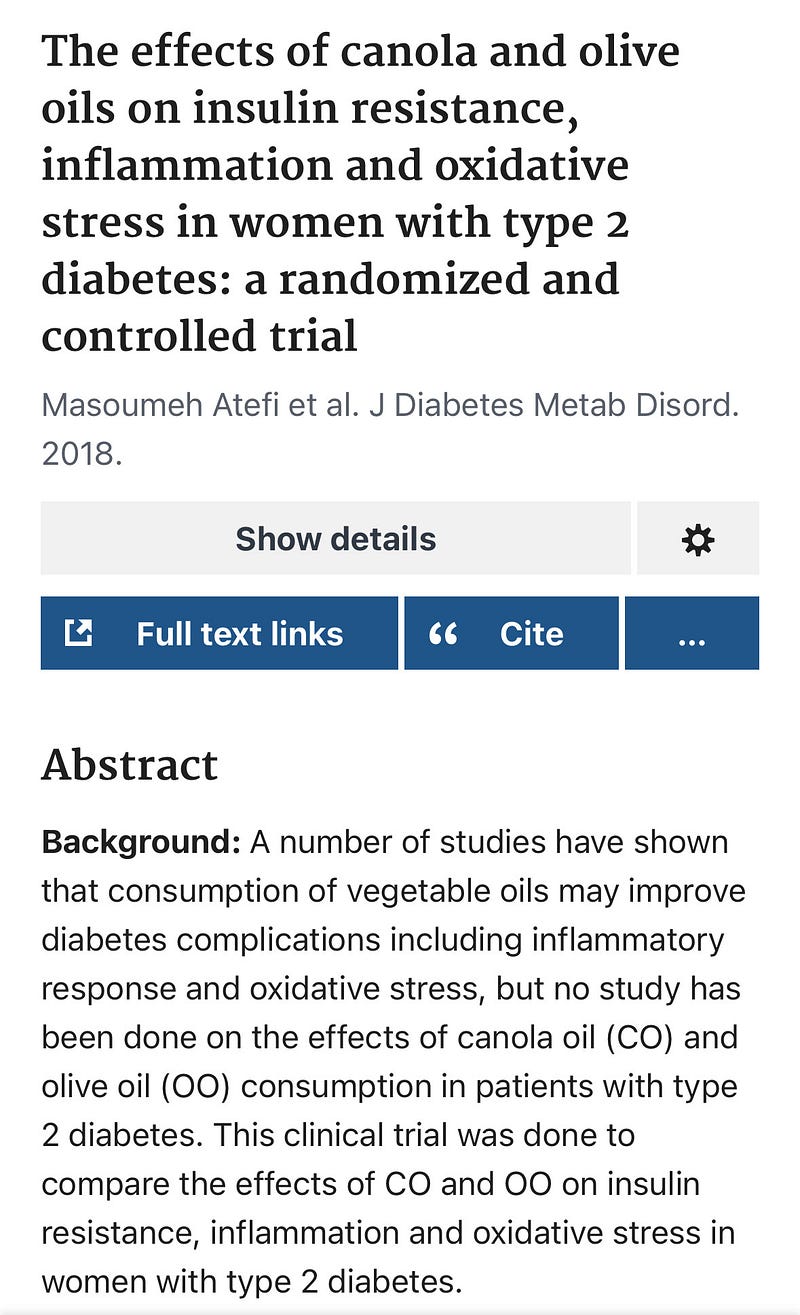
Calories count but with seed oils, it’s not a one-for-one comparison since one is harmful to your body and the other isn’t. We see this in calorie consumption studies. It’s a complex web of hunger signaling and cravings that contribute to increased calorie consumption versus a diet of high quality nutrients that don’t result in metabolic derangement.
I’m sure someone who is only concerned about calories will disagree but logically speaking in nonscientific terms here, if a calorie from a seed oil mucks up your machinery in ways that a calorie from coconut oil does not, and even if you can effectively burn both of those calories, there’s still residual damage inside your body. Metabolically you aren’t as healthy even though you are assuming you can burn both calories equally.
I have hired bodybuilding coaches in the past. I have done if it fits your macros. I have had the liberty to have cereal or Doritos or a Snickers bar during a diet. I also had to do an hour of cardio five to six times a week in addition to weight training.I got lean, but at what cost? Could I have achieved that same weight loss sooner by not eating processed foods and stabilizing my blood sugar more efficiently? I think so.
Everyone should agree that chronic processed food consumption isn’t healthy but as long as I did my hour of cardio I had abs. Assuming I kept this diet approach up, how sustainable was it? Not very.
In his excellent piece, Dr. Chris Masterjohn states the following about seed oils and obesity
Given the complexity of lipid peroxidation, it should be regarded as a hypothesis worthy of much more investigation that lipid peroxidation in the hypothalamus could hurt energy balance, with the acknowledgment that there are lots of contextual factors that will determine the effect.
It may be that this is more important during early development, or that it is more relevant in free-living subjects where they have more choices to consume more hyper-palatable food.
Further, it could be that foods in 2024 are much more hyper-palatable than those in the 1960s, and that moderate hypothalamic damage from an interaction between long-term seed oil intake and oxidants could put one at a disadvantage in wading through the morass of hyper-palatability.
You still can’t out train a bad diet especially when there may be additional metabolic consequences.
Seed Oils Aren’t Heart Healthy At All
Seed oils are not heart healthy regardless of what sticker BIG FOOD puts on the bottle. Typically speaking, when individuals consume seed oils their LDL “bad” cholesterol does go down due to improved LDL receptor activity. That is the only benefit that the pro seed oil crowd will tell you. They will stop the conversation right there.
Seed oils decrease LDL because the LDL particles are oxidized and turned into “foam cells” and then reabsorbed as plaque in your arteries. (17)
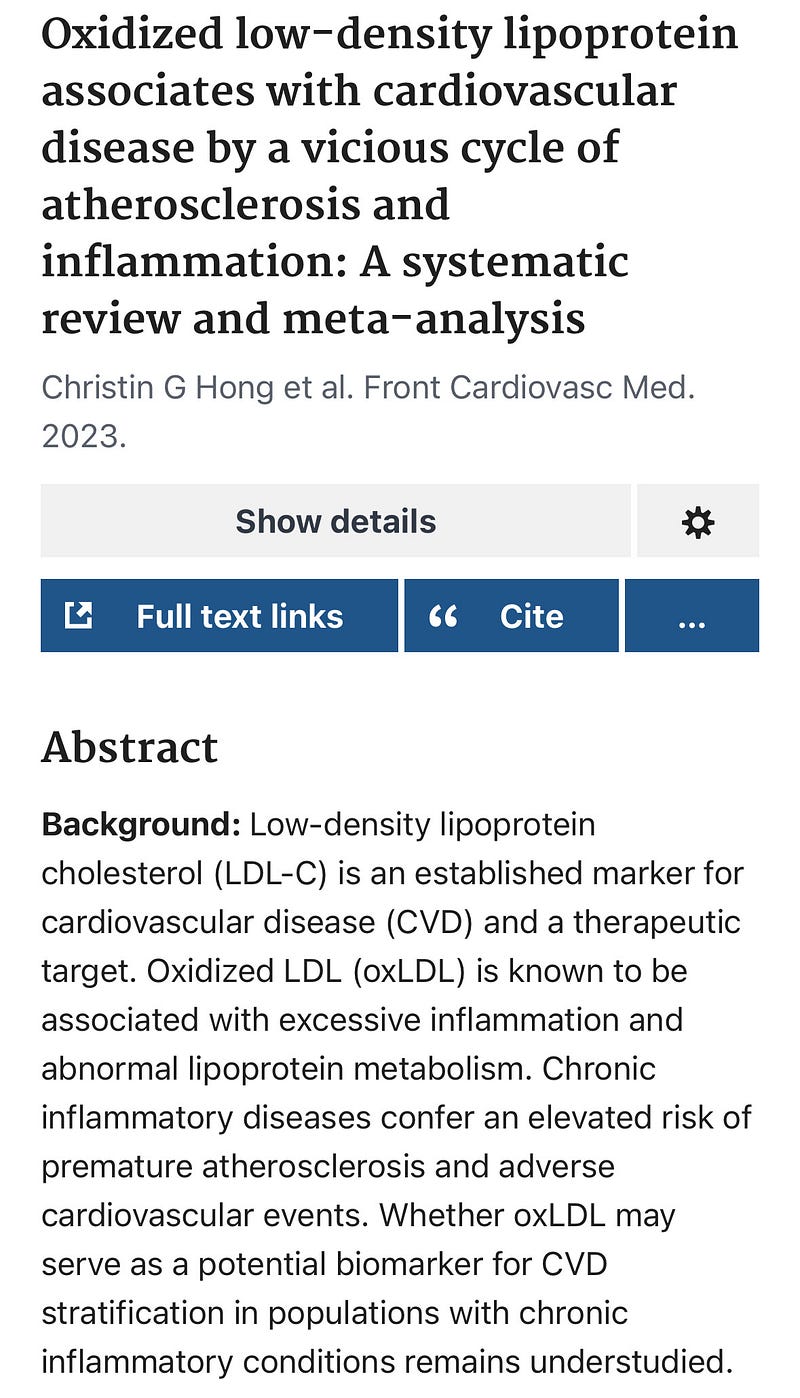
Hang your hat on seed oils reducing LDL but realize that you’re not improving your heart health or lowering your risk of heart disease.
Seed oil consumption is a huge predictor of LDL being oxidized or not. Oxidized LDL is more closely associated with heart disease risk and inflammation than elevated LDL. (18)
Longer term studies find higher intake of polyunsaturated fats associated with greater all cause mortality (21).
Do you have high LDL and high inflammation as measured by HsCrp or homocysteine? That’s problematic because now your cardiovascular health is getting bombarded from two sides.
Is lowering LDL across the board a healthier and better thing? Does it lower LDL and lower your risk for cardiovascular disease? (26)
There’s even a debate about lowering LDL being harmful. What costs would need to be achieved to bring us near teenage levels of LDL?
How low is safe?
What does the seed oil do to the quality of the LDL particle? Maybe this is the canary in the coal mine. We still don’t know.
Seed Oils, Headaches and Neuro Inflammation
Oxidized metabolites from linoleic acid are associated with chronic headache symptoms. (19)
56 individuals with chronic headaches were separated into two groups. One group had a high linoleic acid intake and the other had a low linoleic acid intake for 12 weeks. Only the low linoleic acid group experienced reduced headaches due to a significant reduction of linoleic acid oxidized properties (OXLAMS) (29)
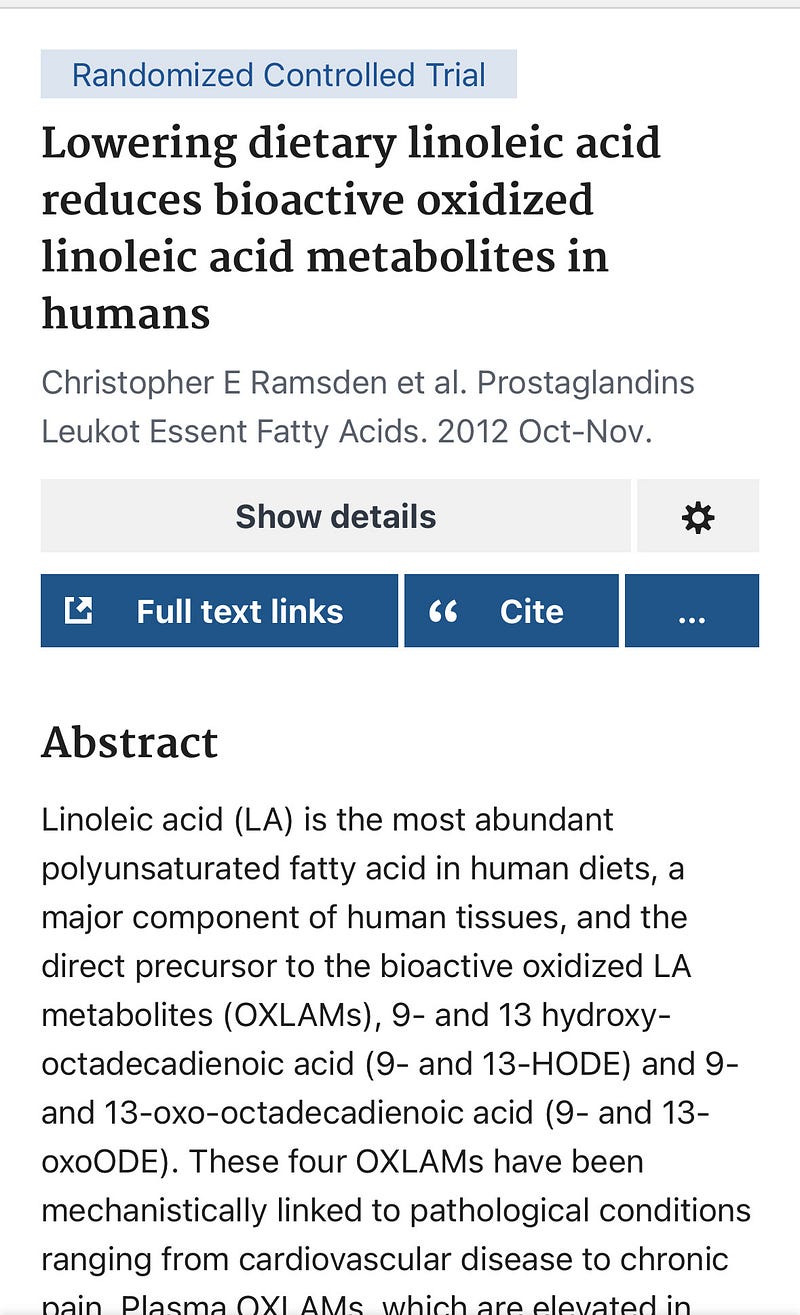
Mental Gymnastics: Seed Oils Are Healthy
What about when your favorite nutrition coach, bodybuilder, or influencer posts a video or article saying that seed oils are healthy and they show research supporting it? It’s either a heavy user bias or they don’t care to objectively dive into the research. Again, you can take a bath in seed oils if you would like. It’s your preference.
Just because they have a lot of followers or are jacked doesn’t mean that they are immune to being headline readers too.
Studies Show Seed Oils Are Healthy
The majority of studies in the last 30–40 years use linoleic acid NOT a Seed Oil. It’s worth repeating that linoleic acid from a whole food source is substantially different than a processed seed oil which happens to contain linoleic acid.
The older studies that used seed oil were compared to HIGH saturated fat and HIGH calorie diets devoid of nutrient density. If the authors made the nonseed oil group drop their calories or improve the quality of food it obviously would result in biomarker improvement independent of the seed oil. It’s not the seed oil.
Why Do Observational Studies Show Health Improvements In Seed Oils?
There are a lot of healthy foods containing linoleic acid. There’s also the user’s diet before adding or increasing seed oil consumption. What are you improving from? What is the comparison? What are both groups consuming in totality?
Some of it is the fact that we have been told for decades that they are heart healthy. People do that, they just repeat what they hear.
Is Cold Expellar Pressed Canola Oil A Healthy Alternate?
No
I’ve been seeing this a lot lately in health food stores. Essentially it’s a newer form of canola oil that mixes expeller press canola oil with cold pressed canola oil. These companies are taking the term “cold pressed”, which has significance for olive oil, and just slapping it on a seed oil. All “organic expeller pressed” means is that they use less or no hexane in the production while this new version of cold expeller pressed is still jam packed with the other toxic by-products.
What Can We Do To Stop The Negative Benefits of Seed Oils?
Just Stop
For starters, just stop consuming seed oils in general. Check your labels and don’t limit them, remove them. Less linoleic acid intake will lead to less stored linoleic acid with time.
I’m not suggesting that you never eat out again. I’m realistic. You will make a profound change by controlling what you can control in your diet by checking labels, eating less processed foods, and cooking with healthier options like tallow, extra virgin olive oil, avocado oil, and coconut oil.
Consume More Omega-3 Supplements And Foods
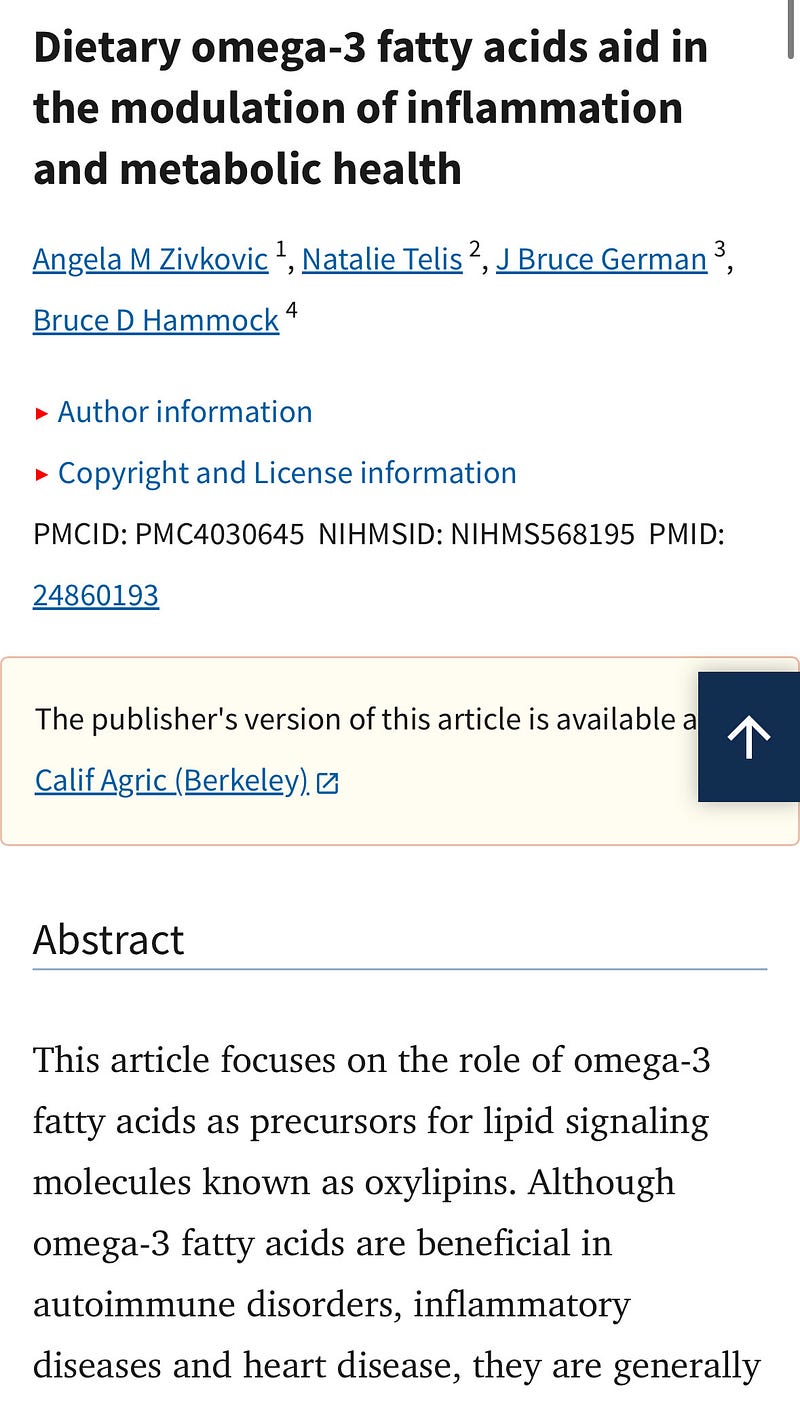
Studies have validated that when omega 6 intake is elevated with a small amount of omega 3, there are fewer deleterious effects than when omega 6’s are consumed alone. This is due to omega 6’s and omega 3’s competing at the cellular level. Even when combined with omega-3’s, the omega 6’s still oxidized into harmful properties. There was still damage to the mitochondria. While you can’t completely counterbalance the omega 6 to omega 3 ratio with supplementation or high omega 3 foods alone, it is important. (24,25)
Glycine And Spirullina
According to Dr.James Dinicolantonio, 5 grams of the amino acid glycine four times per day and 2–4 grams of spirulina can help counter the harmful effects of oxidized seed oils.
Consume Supplements When You Consume Seed Oils
For those times when you are out with friends or in a pinch and absolutely can not avoid seed oils, I favor supplementation. Bringing some fish oil, krill oil, or astaxanthin capsules and taking them before your meal can add some favorable omega 3s. Dr. Chris Masterjohn has suggested that consuming Vitamin E may neutralize the oxidative damage of seed oils when taken together. The Vitamin E will not last as long as the seed oil will but it is another addition that you should consider. (30)
I’m not saying this eliminates the seed oil consequences but it’s your best effort to keep the omega 6 to omega 3 balance in the good favor.
Eat Less Chicken, Pork, And Eggs
I do consider eggs to be a very healthy food as they are packed with micronutrients but if you reduce or eliminate your intake of chicken, pork, and eggs in favor of wild caught fish, game meat, or grass fed beef you are more favorably balancing the ratio. Chicken and pork are fed grains high in linoleic acid and the eggs come from hens fed similarly. Don’t cut these foods out first, stop ingesting seed oils, but it is another option depending how deep down the rabbit hole you would like to go.
You have to consider the chronic consumption long term and the mounting evidence for the negative impacts of seed oils on your heart, metabolism, cells, and brain. It’s okay to question if they should be included in your diet. It’s not wrong to present the mounting evidence against seed oils and decide for yourself.
Ultimatelty this is YOUR health. You decide.
When they tell you that you can’t question something, question it the most.
About The Author
Phil James, MS,CSCS is a reader, runner, lifter and researcher of all things fitness and nutrition. You can check out his all natural Physique Formula Supplements on his website.
References
1) https://pmc.ncbi.nlm.nih.gov/articles/PMC7666899/
2)https://pubmed.ncbi.nlm.nih.gov/26950145/
3) https://pmc.ncbi.nlm.nih.gov/articles/PMC6269634/
4) https://pubmed.ncbi.nlm.nih.gov/26950145/
5) (https://pmc.ncbi.nlm.nih.gov/articles/PMC9655691/)
6) https://pubmed.ncbi.nlm.nih.gov/30514131/
7) https://pmc.ncbi.nlm.nih.gov/articles/PMC8769064/
8)https://pmc.ncbi.nlm.nih.gov/articles/PMC6196963
9) https://pmc.ncbi.nlm.nih.gov/articles/PMC3076650/
10) https://pmc.ncbi.nlm.nih.gov/articles/PMC10386285/
11) https://pubmed.ncbi.nlm.nih.gov/26567191/)
12)(https://pubmed.ncbi.nlm.nih.gov/12324234/) 13: https://www.aging-us.com/article/100005/text)
14 (https://pubmed.ncbi.nlm.nih.gov/16644178/)
15: (https://pmc.ncbi.nlm.nih.gov/articles/PMC10752590/)
16) https://pmc.ncbi.nlm.nih.gov/articles/PMC2806111/
17) (https://pmc.ncbi.nlm.nih.gov/articles/PMC6196963/)
18) https://pmc.ncbi.nlm.nih.gov/articles/PMC9885196/
19) https://pmc.ncbi.nlm.nih.gov/articles/PMC3467319/
20) https://pmc.ncbi.nlm.nih.gov/articles/PMC10475008/
21) https://pmc.ncbi.nlm.nih.gov/articles/PMC7155260/
22)https://pubmed.ncbi.nlm.nih.gov/30918840/
23) https://www.europarl.europa.eu/factsheets/en/sheet/51/food-safety
24) (https://pubmed.ncbi.nlm.nih.gov/18408140/)
25 (https://nutrition.ucdavis.edu/outreach/nutr-health-info-sheets/pro-fat)
26) https://pubmed.ncbi.nlm.nih.gov/33463677/
27) https://www.statista.com/statistics/301044/edible-oils-consumption-united-states-by-type/
28) https://pmc.ncbi.nlm.nih.gov/articles/PMC5129750/
29) https://pmc.ncbi.nlm.nih.gov/articles/PMC3303216/
30) https://pubmed.ncbi.nlm.nih.gov/26291567/
